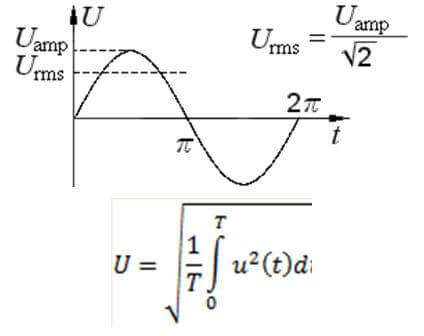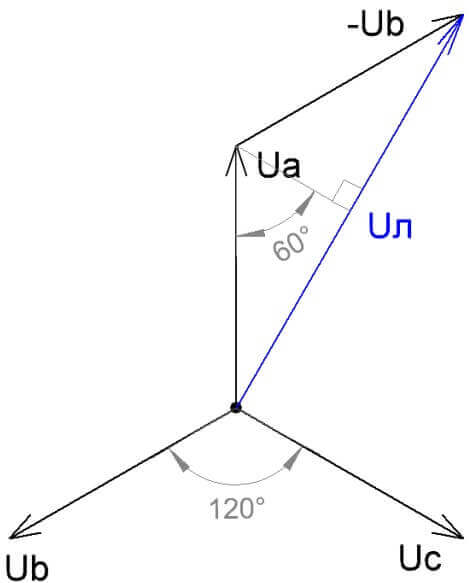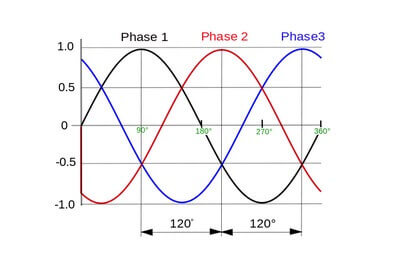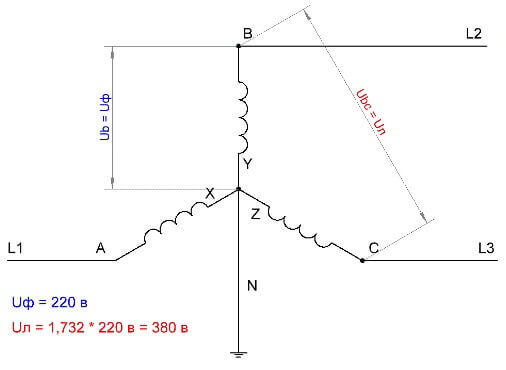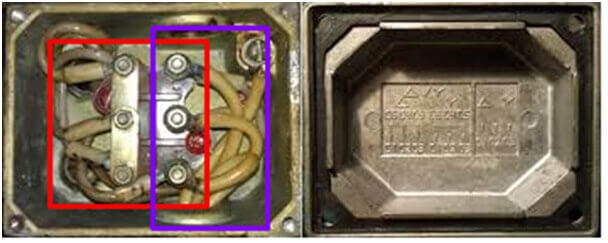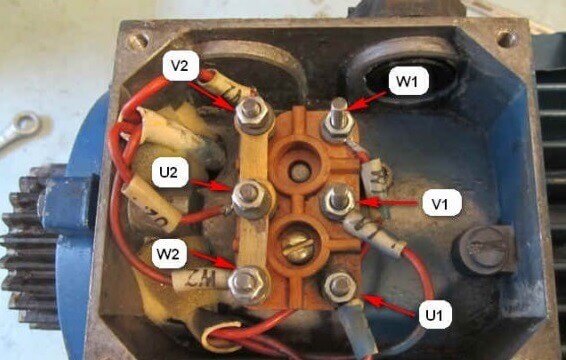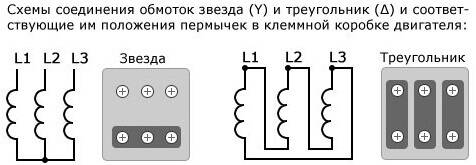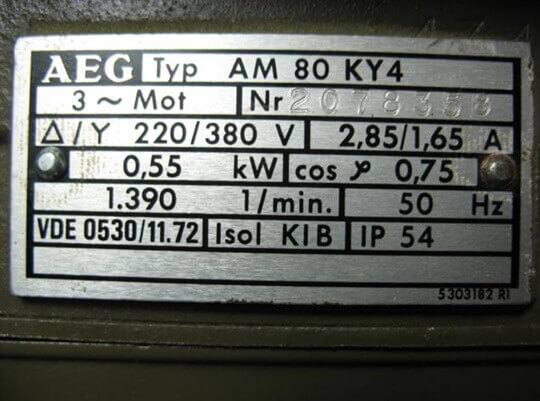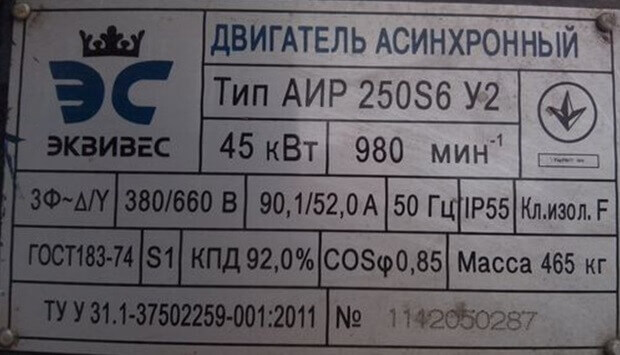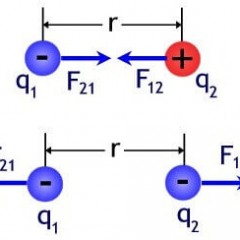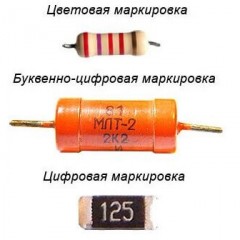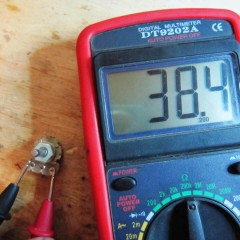What is the linear and phase voltage, what is their ratio?
AC voltage and its magnitude
Voltage is distinguished by the nature of the current: alternating and constant. A variable can be of various shapes, the main point is that its sign and size change over time. At a constant, the sign is always of the same polarity, and the value can be stabilized or unstabilized.
In our outlets, the voltage is alternating with a sinusoidal shape. Its different values are distinguished, the most commonly used concepts are instantaneous, amplitude and acting. As the name implies, instantaneous voltage is the number of volts at a particular point in time. Amplitude is the amplitude of the sinusoid relative to zero in volts, the acting is the integral of the voltage function over time, the ratio between them is: the acting is √2 or 1.41 times less than the amplitude. Here's what it looks like on a chart:
Three-phase voltage
In three-phase circuits, two types of voltage are distinguished - linear and phase. To understand their differences, you need to look at the vector diagram and graph. Below you see three vectors Ua, Ub, Uc - these are voltage or phase vectors. The angle between them is 120 °, sometimes they say 120 electrical degrees. This angle corresponds to that in the simplest electrical machines between the windings (poles).
If we reflect the vector Ub so that its angle of inclination is preserved, but the beginning and end are reversed, its sign will be reversed. Then we set the beginning of the vector –Ub to the end of the vector Ua, the distance between the beginning of Ua and the end –Ub will correspond to the linear voltage vector Uл.
In simple words, we see that the magnitude of the linear voltage is greater than the phase. Let's analyze the voltage diagram in a three-phase network.
The red vertical line marks the linear voltage between phase 1 and phase 2, and the yellow line marks the phase amplitude phase 2.
BRIEFLY: Linear voltage is measured between phase and phase, and phase voltage between phase and zero.
From the point of view of calculations, the difference between the voltages is determined by the solution of this formula:
Linear voltage is greater than phase voltage by √3 or 1.73 times.
The load to the three-phase network can be connected via three or four wires. The fourth conductor is zero (neutral).Depending on the type, the network can be isolated neutral and grounded. In general, with a uniform load, three phases can be fed without a neutral wire. It is needed so that voltages and currents are distributed evenly and not phase imbalance, and also as a protective. In dead-earthed networks, in the event of a breakdown, an automatic disconnector will break out on the case or the fuse in the switchboard will blow, so you will avoid the danger of electric shock.
The great thing is that in such a network we simultaneously have two voltages that can be used based on the requirements of the load.
For example: Pay attention to the electrical panel in the entrance of your house. Three phases come to you, and one of them and zero is brought into the apartment. Thus, you get 220V (phase) in sockets, and 380V (linear) between phases in the staircase.
Schemes of connecting consumers to three phases
All engines, powerful heaters and other three-phase loads can be connected in a star or delta circuit. Moreover, most electric motors in boron have a set of jumpers, which, depending on their position, form a star or a triangle of windings, but more on that later. What is a star mix?
Star connection involves connecting the generator windings in such a way that the ends of the windings are connected at one point, and a load is connected to the beginning of the windings. The star also connects the windings of the engine and powerful heaters, only instead of the windings they are heating elements.
Let's talk about an electric motor as an example. When connecting its windings with a star, a linear voltage of 380 V is applied to the two windings, and so with each pair of phases.
In Figure A, B, C are the beginning of the windings, and X, Y, Z are the ends connected to one point and this point is grounded. Here you see a network with a grounded neutral (wire N). In practice, it looks like in the photo of the electric motor:
The ends of the windings are highlighted in a red square, they are connected by jumpers, this arrangement of jumpers (in line) indicates that they are connected by a star. In blue - feeding three phases.
In this photo, the beginnings (W1, V1, U1) and the ends (W2, V2, U2) are marked, pay attention to the fact that they are shifted relative to the beginnings, this is necessary for convenient connection into a triangle:
When connected to a triangle, a linear voltage is applied to each winding, this leads to the fact that large currents flow. The winding must be designed for such a connection.
Each of the switching methods has its own advantages and disadvantages; some engines generally switch from star to triangle during the start-up process.
Nuances
Continuing the conversation about engines, one cannot ignore the question of choosing a switching circuit. The fact is that usually the engine on its nameplate contains the marking:
In the first line you see the legend of the triangle and the star, note that the triangle goes first. Further, 220 / 380V is the voltage at the triangle and star, which means that when connecting with a triangle, the linear voltage should be equal to 220V. If your network voltage is 380 - then you need to connect the motor to the star. While the phase is always 1.73 less, regardless of the linear value.
A great example is the following engine:
Here, the rated voltage is already 380/660, which means that it must be connected with a triangle for a linear 380, and the star is designed to be powered from three phases of 660V.
If in powerful loads they often operate with the values of interfacial voltage, then in lighting circuits in 99%% of cases they use phase voltage (between phase and zero). An exception is electric cranes and the like, where a transformer with secondary windings with a linear 220 V can be used. But this is rather the subtleties and specificity of specific devices. It is easier for beginners to remember this way: phase voltage is that which is in the outlet between phase and zero, linear - in line.
Surely you do not know:

